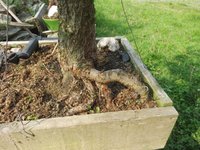Forsoothe!
Imperial Masterpiece
meh...
Yes, just collected last Friday. OK on letting it grow unmolested through 2021. I do plan to treat it for borers though.You just pulled this out of the ground a few days ago?
No real work on the tree till 2022
The trees seem fine as long as I keep them watered well.reminds me of my eastern hemlock (im sure youre familiar, theyre in the northeast) yamadori
but i havent done much at all to it, to let it fill out!!
how does your tree do in this hot weather?




I’m curious. Are you planning g to style the tree as a alpine conifer (branches down to show age with pads of needles) or as a deciduous tree with fine ramification (branches up)? If you’re looking for alpine style, what if you wire the branch marked in red down to fill in the empty spot on the trunk?Update on the tamarack collected in post one of this thread. That one had the leader chopped shortly after collection. It has a problem with the middle section with out branches, especially to the left (photo Tam One c). I was considering trying a graft to add a branch at that area, but now there is a bud starting a branch there. I also contemplated another chop and making a new leader about 2 inches above the first chop to introduce more taper (photo Tam one e). The top of the tree looks interesting to me and, if it were easier to air layer these larix, I would consider that. Any opinions on where to go with this tree?
